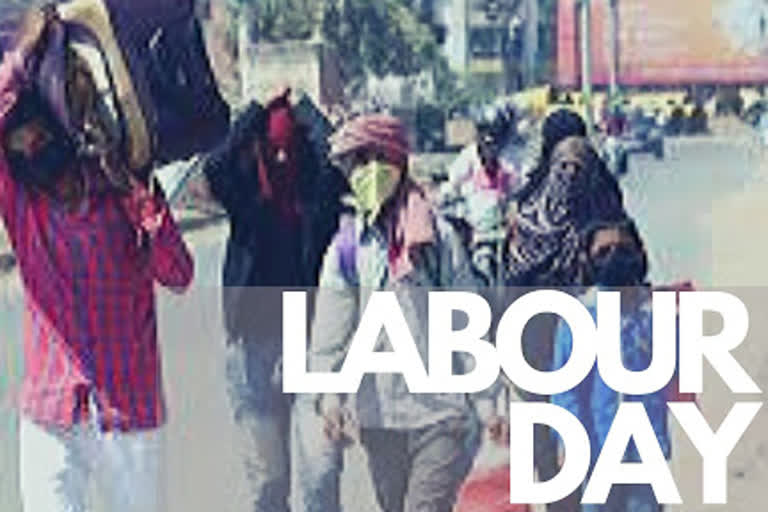Hyderabad: May 1 is observed around the globe as May Day, Labour Day or International Workers’ Day, in a bid to commemorate the contribution of workers and the historic labour movement.
However, this year’s May Day celebrations won’t be the same, given the nationwide lockdown imposed to contain the spread of coronavirus disease and the consequential job loss among the working class, particularly the daily wage earners and those engaged in the unorganised sector.
With factories, restaurants, shops, construction industry and other businesses shut for over a month, and no social security in place, hundreds of thousands of migrant workers have been left with no income opportunities.
Facing starvation and no public transport in sight, lakhs of migrant workers have begun a long march home to their villages hundreds of kilometres away from the country’s urban spaces in a desperate bid to find shelter, dignity, food and possibly a shred of familiarity.
This lockdown has, as novelist Arundhati Roy said in her article for the Financial Times, “worked like a chemical experiment that suddenly illuminated hidden things...as the wealthy and the middle classes enclosed themselves in gated colonies, our towns and megacities began to extrude their working-class citizens — their migrant workers — like so much unwanted accrual.”
Labour, supply chain and lockdown
The lockdown and resultant migration have created an acute labour shortage in markets, factories, industries, warehouses, transportation and distribution, thereby impacting the supply chain.
Businesses are struggling to deploy 20% of the required labour force, and factories are working at lower capacity and labour thus producing less than what is usually produced.
The severity of the situation can be gauged from the fact that the Delhi government has recently asked the trade unions to help it find the required labour for the factories, warehouses, transportation and distribution of essential commodities.
Agriculture and lockdown
The uncertainty of the availability of nearly 10 lakh migrant workers and the lack of mechanical transplanting options have made farmers in Punjab and Haryana choose cotton over rice plantations, as per an Indian Express report.
Paddy farming is labour-intensive and the lockdown has forced the “cheap labour” to return to their native places.
According to the International Labour Organisation’s estimate, which is based on Census 2011 figures, around 24 lakh migrants work in fields across India.
Resetting of market and migration trends
The coronavirus lockdown is said to reset the market and migration trend of labour in India.
The behavioural changes predicted by experts state that once the lockdown is lifted, most of the labour force might choose to work at lower wages in the close and safe vicinity of their native places.
Also read: PM Modi holds a meeting to discuss ways to boost Defence & Aerospace Sector
Also, the market could see a steep price hike due to the loss of “cheap labour” and the use of local but costly labour.
Pre-lockdown
Even before the lockdown was put in place, the country stared at high unemployment rates, but then, as critics suggest, the unplanned imposition of the lockdown led to a further crisis in an already volatile labour market.
As per the Centre for Monitoring Indian Economy (CMIE), labour participation in the country fell to 35.4% in the week ended April 26 compared to 42.6% in the week ended March 22, just before the national lockdown, suggesting 72 million people quit the labour markets during the lockdown.
The CMIE further points out that the national lockdown did not just throw 72 million out of the labour force but also drove another 85 million to a desperate search for jobs in the midst of a national lockdown when none were available.
Labour in India
As per the labour bureau data, an estimated 12 crore of India’s 46.5 crore workforce are migrant workers, and 25 per cent of rural households and 12 per cent of urban households rely on casual labour as their main source of income, according to the most recent labour statistics.
Over 40% of those in urban areas are now in “regular" or salaried jobs but these do not necessarily come with job security.
Nearly half of salaried workers in non-agricultural jobs are not entitled to any social security benefits including health care.
The Periodic Labour Force Survey (PLFS) 2017 - 18 carried out by the National Sample Survey Organisation (NSSO), states that 71% of workers in the country don’t have any written job contract, 54% don’t get paid leave and over 57% in rural areas and nearly 80% in urban areas work much beyond the eight-hour workday (48-hour-week).
The report also reveals that over 52% of workers are actually ‘self-employed’, which means they may be doing farming or running petty shops or enterprises largely with their own labour, or service providers of various kinds. About a quarter of working people are casual workers, getting work and earnings on a daily basis, while nearly a quarter (23%) are regular wage or salary-earning employees.



